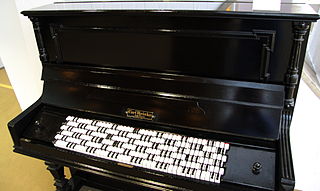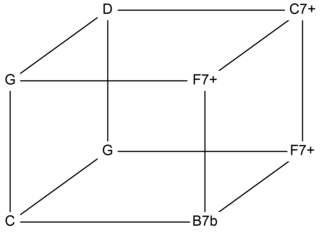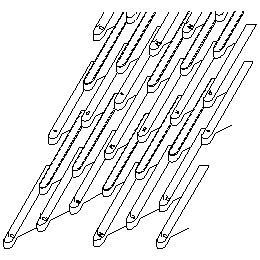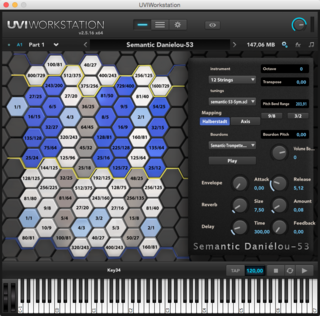
A musical keyboard is the set of adjacent depressible levers or keys on a musical instrument. Keyboards typically contain keys for playing the twelve notes of the Western musical scale, with a combination of larger, longer keys and smaller, shorter keys that repeats at the interval of an octave. Pressing a key on the keyboard makes the instrument produce sounds—either by mechanically striking a string or tine, plucking a string (harpsichord), causing air to flow through a pipe organ, striking a bell (carillon), or, on electric and electronic keyboards, completing a circuit. Since the most commonly encountered keyboard instrument is the piano, the keyboard layout is often referred to as the piano keyboard.

Meantone temperament is a musical temperament, that is a tuning system, obtained by narrowing the fifths so that their ratio is slightly less than 3:2, in order to push the thirds closer to pure. Meantone temperaments are constructed the same way as Pythagorean tuning, as a stack of equal fifths, but it is a temperament in that the fifths are not pure.

The Jankó keyboard is a musical keyboard layout for a piano designed by Paul von Jankó, a Hungarian pianist and engineer, in 1882. It was designed to overcome two limitations on the traditional piano keyboard: the large-scale geometry of the keys, and the fact that each scale has to be fingered differently. Instead of a single row, the Jankó keyboard has an array of keys consisting of two interleaved manuals with three touch-points for every key lever, making six rows of keys. Each vertical column of three keys is a semitone away from the neighboring ones, which are in the alternate rows. Thus within each row the interval from one note to the next is a whole step.
The spaces described in this article are pitch class spaces which model the relationships between pitch classes in some musical system. These models are often graphs, groups or lattices. Closely related to pitch class space is pitch space, which represents pitches rather than pitch classes, and chordal space, which models relationships between chords.

A pedalboard is a keyboard played with the feet that is usually used to produce the low-pitched bass line of a piece of music. A pedalboard has long, narrow lever-style keys laid out in the same semitone scalar pattern as a manual keyboard, with longer keys for C, D, E, F, G, A and B, and shorter, raised keys for C♯, D♯, F♯, G♯ and A♯. Training in pedal technique is part of standard organ pedagogy in church music and art music.
An enharmonic keyboard is a musical keyboard, where enharmonically equivalent notes do not have identical pitches. A conventional keyboard has, for instance, only one key and pitch for C♯ and D♭, but an enharmonic keyboard would have two different keys and pitches for these notes. Traditionally, such keyboards use black split keys to express both notes, but diatonic white keys may also be split.

Hans Luedtke was a German inventor in the field of music.
George Secor was an American musician, composer and music-theorist from Chicago. He was the discoverer of miracle temperament and eponym of the secor.

In music theory and tuning, an Euler–Fokker genus, named after Leonhard Euler and Adriaan Fokker, is a musical scale in just intonation whose pitches can be expressed as products of some of the members of some multiset of generating prime factors. Powers of two are usually ignored, because of the way the human ear perceives octaves as equivalent.

Henry Ward Poole (1825–1890) was an American surveyor, civil engineer, educator and writer on and inventor of systems of musical tuning. He was brother of the famous librarian William Frederick Poole, and cousin of the celebrated humorist, journalist and politician Fitch Poole.

Robert Holford Macdowall Bosanquet was an English scientist and music theorist, and brother of Admiral Sir Day Bosanquet, and philosopher Bernard Bosanquet.

In music, 31 equal temperament, 31-ET, which can also be abbreviated 31-TET or 31-EDO, also known as tricesimoprimal, is the tempered scale derived by dividing the octave into 31 equal-sized steps. Play (help·info) Each step represents a frequency ratio of 31√2, or 38.71 cents.
Mayer Joel Mandelbaum is an American music composer and teacher, best known for his use of microtonal tuning. He wrote the first Ph.D. dissertation on microtonality in 1961. He is married to stained glass artist Ellen Mandelbaum, and is the nephew of Abraham Edel.

In musical tuning systems, the hexany, invented by Erv Wilson, represents one of the simplest structures found in his combination product sets.
An isomorphic keyboard is a musical input device consisting of a two-dimensional grid of note-controlling elements on which any given sequence and/or combination of musical intervals has the "same shape" on the keyboard wherever it occurs – within a key, across keys, across octaves, and across tunings.
Dynamic tonality is a paradigm for tuning and timbre which generalizes the special relationship between just intonation and the harmonic series to apply to a wider set of pseudo-just tunings and related pseudo-harmonic timbres.

The Wicki–Hayden note layout is a compact and logical musical keyboard layout designed for concertinas and bandoneons.

The Harmonic Table note-layout, or tonal array, is a key layout for musical instruments that offers interesting advantages over the traditional keyboard layout.

In musical tuning, a lattice "is a way of modeling the tuning relationships of a just intonation system. It is an array of points in a periodic multidimensional pattern. Each point on the lattice corresponds to a ratio. The lattice can be two-, three-, or n-dimensional, with each dimension corresponding to a different prime-number partial [pitch class]." When listed in a spreadsheet a lattice may be referred to as a tuning table.

The Semantic System is based on a microtonal musical scale tuned in just intonation, developed by Alain Daniélou.















